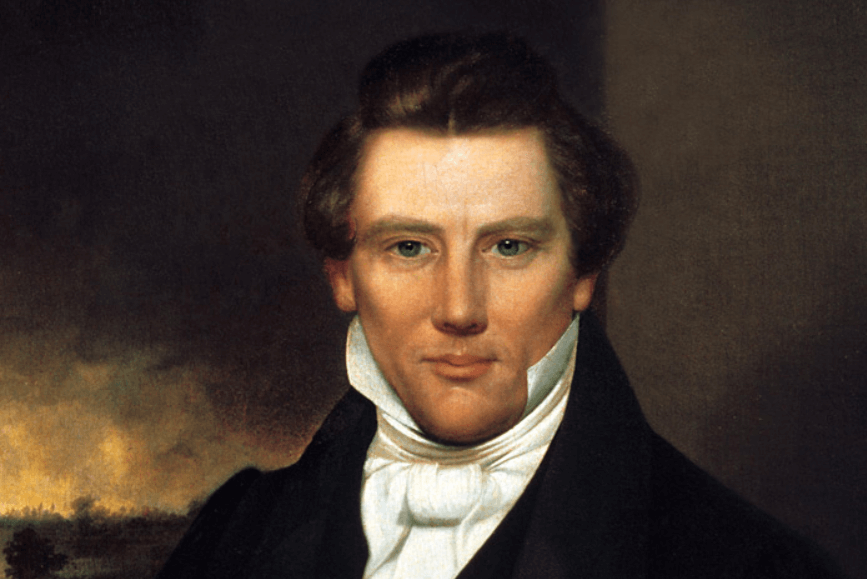Who was Joseph Smith? Information on the origins of Mormon church, history of Mormons and Joseph Smith biography, life story.

Source: wikipedia.org
Joseph Smith; (1805-1844), founder of the Church of Jesus Christ of Latter Day Saints, usually called the Mormon Church. His monument is the large native American church body that in the 20th century came to be a powerful and widely respected element in religious life.
Smith was born in Sharon, Vt., on Dec. 23, 1805, the son of Joseph and Lucy Mack Smith. The family settled in Palmyra, N. Y., in 1815. Smith’s formal education was brief, and little is known of the origins of his thought. He seems to have been regarded as witty and argumentative, with a sensitive and turbulent nature that made him greatly disturbed by the many competing religious sects then operating in western New York state. These were the last years of a series of evangelistic revivals in an area that historians have come to call “the burnt-over district.”
Origins of the Mormon Church.
At the age of 14, Smith experienced a deep religious melancholy that, he later recounted, was relieved by a vision which impressed him deeply but of which he spoke little. In his later account of this period, written in 1838, he described seeing two Personages—apparently God the Father and Jesus Christ—who told him not to join any of the sects operating around him. He had a series of visions in September 1923, in which the angel Moroni appeared and said that God had work for Smith to do. The angel prophesied forthcoming judgments upon the earth and described a book written on “gold plates,” and two “stones” in silver bows called the Urim and Thummim and fastened to a breastplate, for use in translating the book. The book would describe former inhabitants of the continent and their origins, and would contain “the fullness of the everlasting Gospel.” While the angel spoke, Smith had a vision of the plates and their exact location. In his history, Smith describes his finding the plates in a stone box under a large rock at a hill called Cumorah near Manchester, N. Y., but he was forbidden to remove them until four years had passed or to reveal them to anyone. Finally they were delivered to him by the angel messenger on Sept. 22, 1827.
When it became known that Smith had the plates, he came under such pressure to reveal them that he moved with his wife to Susquehanna county, Pa., where he began copying the ancient characters (which he described as ancient Egyptian, Chaldaic, Assyriac, and Arabic) and translating them with the help of the Urim and Thummim stones. In March 1830 the messages of the plates were printed in the Book of Mormon, which, with two later revelations of Smith—A Booh of Commandments (1833) and Doctrine and Covenants (1835)—were basic to the practical and doctrinal development of Mormonism.
The Book of Mormon tells of the transfer of God’s holy people from the Old World to North America in ancient times. Internecine warfare led to the end of these communities in 421 a. d., but not before the angel Moroni had hidden the plates with the revelation. The descendants of the remnants of these people were the American Indians. Smith was to be the latter-day prophet to restore the church in America.
Founding of the Church.
On April 6, 1830, at Fayette, N. Y., Smith formally founded the Church of Jesus Christ of Latter-day Saints, whose members were at first chiefly relatives and neighbors. In November 1830, Smith was joined by Sidney Rigdon, a brilliant Mormon leader, and the church grew rapidly. Mormonism borrowed from or paralleled other religious movements of the day, marked as they were by the vision of an expanding America. Smith ruled with a firm hand, both by the strength of his personality and by his organizing ability. In 1831 he moved his community to Kirtland, Ohio, and soon afterward to Missouri. Unwelcome there, he fled to Illinois in 1839 to a community he renamed Nauvoo. There he became mayor and established his Midwestern headquarters.
Controversy and Assassination.
Growth of the church continued to be rapid. Smith was both admired and scorned—adored by most members of his community and misunderstood by his non-Mormon neighbors. He became a prominent if controversial figure, and in February 1844 he announced his candidacy for president of the United States. Communications with surrounding communities eventually broke down, and Smith’s controversial claims to revelation, including that of polygamy as Mormon doctrine, led to schisms in the group and suppression by outsiders.
When, on June 7, 1844, critics published a sharp attack on him in the Nauvoo Expositor, Smith had its press destroyed and expelled the editor. The incident led to his arrest and confinement, with his brother Hyrum (1800-1844), in a jail in Carthage, 111. On June 27 a mob broke into the jail and shot both men. Smith’s death consolidated his followers, most of whom moved several years later with Brigham Young to Utah. Most Midwestern Mormons later became part of the dissident group known as the Reorganized Church of Jesus Christ of Latter Day Saints.
Smith was married to Emma Hale on Jan. 18, 1827. They had nine children, including Joseph Smith (1832-1914), who became president of the Reorganized Church. The elder Smith is believed to have had a number of wives, variously estimated up to 50, though he acknowledged publicly only his first wife, Emma Hale Smith.